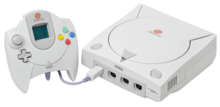
Back Dreamcast AN دريم كاست Arabic دريم كاست ARZ Sega Dreamcast AST Dreamcast AZ Dreamcast BE Sega Dreamcast Catalan دریم کاست CKB Dreamcast Czech Dreamcast CY
 | |
 North American Dreamcast with controller and VMU | |
| Manufacturer | Sega |
|---|---|
| Type | Home video game console |
| Generation | Sixth |
| Release date | |
| Lifespan | 1998–2001 |
| Introductory price | ¥29,000 (equivalent to ¥29,400 in 2019) US$199 (equivalent to $360 in 2023) £200 (equivalent to £370 in 2021) |
| Discontinued |
|
| Units sold | 9.13 million |
| Media | 1 GB GD-ROM, CD-ROM, Mini-CD |
| Operating system | Proprietary |
| CPU | Hitachi SH-4 @ 200 MHz |
| Memory | 16 MB RAM, 8 MB video RAM, 2 MB audio RAM |
| Removable storage | 128 KB VMU |
| Display | Video output formats
|
| Graphics | 100 MHz PowerVR2, integrated with the system's ASIC |
| Sound | 67 MHz Yamaha AICA with 32-bit ARM7 RISC CPU core, 64 channels |
| Online services | Dricas, SegaNet, Dreamarena |
| Dimensions | 195.8 mm × 190 mm × 75.5 mm (7.71 in × 7.48 in × 2.97 in) |
| Mass | 1.5 kg (3.3 lb) |
| Best-selling game | Sonic Adventure, 2.5 million sold |
| Predecessor | Sega Saturn |
The Dreamcast[a] is a home video game console released by Sega on November 27, 1998, in Japan; September 9, 1999, in North America; and October 14, 1999, in Europe. It was the first sixth-generation video game console, preceding Sony's PlayStation 2, Nintendo's GameCube, and Microsoft's Xbox. The Dreamcast was discontinued in 2001, ending Sega's 18 years in the console market.
A team led by Hideki Sato began developing the Dreamcast in 1997. In contrast to the expensive hardware of the unsuccessful Saturn, the Dreamcast was designed to reduce costs with off-the-shelf components, including a Hitachi SH-4 CPU and an NEC PowerVR2 GPU. Sega used the GD-ROM media format to avoid the expenses of DVD-ROM technology. Developers were able to include a custom version of the Windows CE operating system on game discs to make porting PC games easy, and Sega's NAOMI arcade system board allowed nearly identical conversions of arcade games. The Dreamcast was the first console to include a built-in modular modem for internet access and online play.
Though its Japanese release was beset by supply problems, the Dreamcast had a successful US launch backed by a large marketing campaign. However, sales steadily declined as Sony built anticipation for the PlayStation 2. Dreamcast sales did not meet Sega's expectations, and attempts to renew interest through price cuts caused significant financial losses. After a change in leadership, Sega discontinued the Dreamcast on March 31, 2001, withdrew from the console business, and restructured itself as a third-party developer. A total of 9.13 million Dreamcast units were sold worldwide and over 600 games were produced. Its bestselling game, Sonic Adventure (1998)—the first 3D game in Sega's Sonic the Hedgehog series—sold 2.5 million copies.
The Dreamcast's commercial failure has been attributed to a variety of factors, including competition from the PlayStation 2, limited third-party support, and the earlier failures of the 32X and Saturn having tarnished Sega's reputation. In retrospect, reviewers have celebrated the Dreamcast as one of the greatest consoles. It is considered ahead of its time for pioneering concepts such as online play and downloadable content. Many Dreamcast games are regarded as innovative, including Sonic Adventure, Crazy Taxi (1999), Shenmue (1999), Jet Set Radio (2000), and Phantasy Star Online (2000). The console remains popular in the video game homebrew community, which has developed private servers to preserve its online functions and unofficial Dreamcast software.
Cite error: There are <ref group=lower-alpha> tags or {{efn}} templates on this page, but the references will not show without a {{reflist|group=lower-alpha}} template or {{notelist}} template (see the help page).